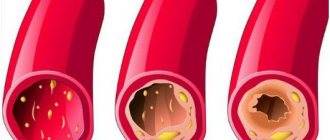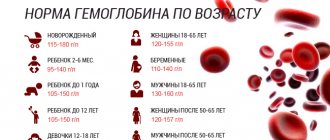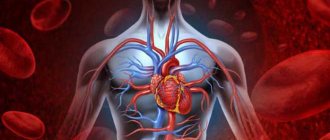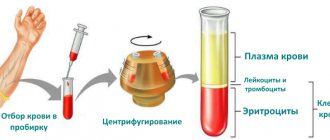What is hemoglobin
Hemoglobin is a protein found in red blood cells. This element acts as a connecting link in metabolism, as it transports oxygen to all internal structures of the body and removes carbon dioxide from them. In addition to helping tissues “breathe,” the protein performs a pigment function, in other words, it gives the blood fluid a red tint.
Fluctuations in the required level of hemoglobin in the blood may indicate a pathological or some kind of stressful condition.
If any changes in the amount of hemoglobin are detected, patients are sent for additional studies, which help to reconstruct a complete clinical picture, and also allow one to diagnose/refute the presence of possible diseases.
Table of hemoglobin norms in the blood of women by age
Women experience many different hormonal changes throughout their lives, which are treated by an endocrinologist. They may be associated with physical overexertion, frequent stress, pregnancy, menstruation or menopause. For these reasons, enzyme concentrations may vary throughout the month and do not indicate the presence of any pathological processes in the body. In addition, depending on the age of the patient, protein levels will also vary.
Nowadays you can find a lot of information on the Internet regarding the norms of various blood parameters, including hemoglobin. The figures indicated there are far from the real situation. The medical guidelines used by doctors indicate clear ranges - the minimum and maximum of each indicator. There is "from and to" for all ages. To treat the patient and determine the further prognosis. For hemoglobin, both the upper and lower limits of normal are important
The standard hemoglobin level in women varies from 120 to 150 g/l. You can evaluate the results of the analyzes by checking the indicated values with the tabular data.
Hemoglobin norm in women - table by age:
| Woman's age | Hemoglobin norm, g/l. |
| 17 — 20 | 120 — 150 |
| 21 — 30 | 120 — 150 |
| 31 — 40 | 120 — 145 |
| 41 — 50 | 120 — 140 |
| 51 — 60 | 120 — 140 |
| 61 — 65 | 120 — 140 |
| more than 65 | 120 — 150 |
Normal hemoglobin level in women aged 30–40 years
The norm at 40 years is at its highest level, after which it gradually begins to decline. Such modifications are associated with hormonal changes in the body that begin to occur during this period. The process of minimizing the concentration of the enzyme in the blood continues throughout subsequent years. Compared to thirty-year-old women, at 40 years old the protein content decreases by 5 g/l.
Normal after 50 years
After 50 years, the norm of hemoglobin in the blood of women decreases noticeably . These modifications can be clearly seen in the table; the indicated indicators do not correspond to normal values. Such disorders are associated with hormonal and emotional instability. Women at this age are susceptible to depression, various experiences) and quickly get tired even with minimal physical exertion (the help of a psychologist can help cope with such conditions.
Normal for women after 60
As indicated in the table, the hemoglobin level in women after 60 years of age becomes critical. This situation is associated with the end of menopausal changes and the minimization of metabolic processes in the body. Hemoglobin in women after 65 years of age has critical indicators, as internal metabolism in tissues slows down.
Hemoglobin norm in men by age
The average standard for adults reaches 140–160 g/l. These boundaries remain in the range of 18-39 years, then red blood cells decrease and hemoglobin decreases. For men over 40 years of age, the typical indicator is 130–150 g/l.
Approximate hemoglobin norms by age can be seen in the table below:
| Man's age | Hemoglobin content g/l |
| First day after birth | 140-200 |
| 1 month | 125-180 |
| 2 months | 100-130 |
| 6 months | 105-140 |
| 1 year | 110-145 |
| 5 years | 105-140 |
| 12 years | 120-150 |
| 15 years | 120-162 |
| 18 years | 118-160 |
| 20-40 years | 140-160 |
| 41-50 years | 130-150 |
| 52-65 years old | 120-145 |
| 70-90 years | 110-135 |
The hemoglobin indicator is a certain number, but not constant. The norm may depend on the country of residence, specific living conditions, the patient’s age, habits, nutrition, and physical activity.
Between 18 and 40 years the figure is 118-160 g/l. This is the period when the values are the most overestimated, not counting newborns. The bodies of men over 30 years of age are subject to physical activity, which causes an increase in the indicator. Even a level of 170 g/l under certain conditions will not be considered a pathology.
After 40 years, healthy men still have high levels of hemoglobin in their bodies. At this age, a level of 140-160 g/l is considered normal. If a person drinks alcohol, moves little, and eats poorly, his levels may drop to 110-120 g/l.
After 50 years of age, a man begins to suffer from various diseases, which worsens his health. In addition, the functional task of the genital organs gradually fades away, which leads to a normal level of 130-150 g/l, provided that the person leads a healthy lifestyle.
Table of hemoglobin norms in men by age
In men, the concentration of hemoglobin in the blood differs significantly from the normal values of the enzyme in women. So, in the male half, its content should not decrease to 130 g/l. and rise above the level of 170 g/l.
Such differences are associated with the production of testosterone in men, which can further enrich blood cells with oxygen.
In addition, the energy costs of the stronger sex are larger, which means the need for air exchange increases.
The norm of hemoglobin in the blood of men, depending on age, is shown in the table:
| Age | Normal hemoglobin g/l. |
| 15 — 18 | 120 — 155 |
| 18 — 30 | 130 — 170 |
| 30 — 40 | 130 — 155 |
| 40 — 60 | 130 — 160 |
The hemoglobin level in men after 30 years gradually begins to decrease. These differences can be analyzed using the table. Such changes are directly related to testosterone production.
As you know, after 40 years, the production of the hormone decreases, and therefore, male libido is gradually suppressed (consultation with a sexologist can solve this problem)
Against the background of ongoing processes, the physical activity of a man is similarly minimized.
In men after 50–60 years, the concentration of the enzyme is minimized, since testosterone virtually ceases to be produced. Therefore, it is regularly necessary to monitor the indicators of blood components and undergo tests. Any deviation from normal values (as indicated in the table) should be immediately eliminated, since at this age there is a high risk of developing anemia and other pathologies associated with the abnormal composition of the blood fluid.
Normal hemoglobin level in men
The normative content of hemoglobin in a man’s blood is different and corresponds to a certain age. In order to correctly navigate and know the required hemoglobin standards in men, doctors have developed a special table. By age, the table helps to determine the required minimum and maximum levels of normal hemoglobin in the blood of men.
The hemoglobin norm in middle-aged men ranges from 150 to 170 g/l; this level of hemoglobin is most acceptable for a young body, full of strength and health, for athletes, and men leading a healthy lifestyle. Proper nutrition and physical activity contribute to the production of additional hemoglobin in a man’s blood, which is necessary for proper metabolism.
After forty years, in men the level of normal hemoglobin in the blood decreases slightly. It is considered normal to have 140 g/l of hemoglobin in a man’s blood. Such indicators are most likely in men who have bad habits and lead a sedentary lifestyle.
When a man reaches the age of fifty, the standard levels of hemoglobin in the blood are significantly lower than in young people. In most cases, this is due to dysfunction of the genitourinary system, various diseases of the heart and blood vessels, and an unhealthy lifestyle.
The permissible norm of hemoglobin in men over sixty years of age is not less than 117 g/l. As a rule, at this age, men experience various diseases of the cardiovascular and genitourinary systems, the person moves little, and many practically do not engage in sports.
Necessary treatment for low levels of normal hemoglobin in a man’s blood.
Table of hemoglobin norms in children by age
In newborns, the density of hemoglobin in the blood has maximum values. Then its content gradually decreases, a certain stability of indicators appears only at 6 months. This condition persists until the child reaches 5 years of age, after which the concentration of the enzyme begins to increase again.
It is also worth considering that when a child reaches the age of 12 years, it is necessary to analyze protein indicators based on his gender. They will be different for boys and girls.
The norm of hemoglobin in the blood of children by age is shown in the table:
| Age | Boys | Girls |
| from 0 to 15 days. | 160 — 200 | 160 — 200 |
| 1 - 3 months | 120 — 160 | 120 — 160 |
| 4 - 6 months | 95 — 140 | 95 — 140 |
| 6 – 12 months | 110 — 145 | 114 — 150 |
| 1 - 2 g. | 110 — 130 | 110 — 130 |
| 2 - 5 l. | 105 — 150 | 105 — 145 |
| 5 - 11 l. | 110 — 140 | 110 — 140 |
| 12 - 14 l. | 120 — 140 | 120 — 140 |
| 15 - 17 l. | 120 — 155 | 120 — 150 |
Age norms of hemoglobin in women
Until the age of 30, a woman’s hemoglobin level is optimal – this is the age of reproductive prime. At age 40, rates increase due to preparation for menopause. After 50, they correspond to hormonal post-menopausal changes in the body. Indicators of age-related hemoglobin norms in the blood of women are presented in the table.
| Age | Norm in g/l |
| 15-30 | 115-160 |
| 40 | 165 |
| 50 | 170 |
| 60 | 117-160 |
| Over 60 | 105-130 |
Only a blood test (BAC) can provide accurate information about hemoglobin levels.
Normal hemoglobin level in blood during pregnancy
During pregnancy, a woman’s amount of enzyme in her blood will differ from the values indicated in the table above. Also, pregnant women should know what medications can and cannot be taken during pregnancy. These deviations are associated with various changes that occur in the body.
Approximate indicators of enzyme content in pregnant women are shown in the table:
| Trimester | Amount of hemoglobin g/l. |
| 1 | 115 — 165 |
| 2 | 110 — 145 |
| 3 | 110 — 140 |
These differences are associated with the end of menstruation and the subsequent growth of the placenta, which requires constant nutrition. Therefore, it is important for the expectant mother to systematically undergo blood tests, since a critical decrease/increase in hemoglobin can become a source of dangerous complications (hypoxia, abnormal fetal development, early birth, underweight of the baby, retardation in mental/physical development, etc.).
Doctor's advice
Often the cause of increased hemoglobin is non-compliance with the drinking regime. The body receives little fluid (less than 1.5-2 liters of clean water per day, tea, coffee and other liquids do not count), this causes the blood to thicken. In this condition, not only hemoglobin, but other indicators also increase - hematocrit, red blood cells, platelets. Hematologists advise that if you have anemia, your diet should focus on meat. Liver and buckwheat are in second place in importance. Next are apples, nuts, cocoa. These same principles apply not only to adults, but also to children.
Victoria Druzhikina Neurologist, Therapist
About the norm of glycated hemoglobin
Glycated or glycosylated hemoglobin is an indicator that helps the patient and doctor control such a dangerous disease as diabetes. Interpretation of test results:
- 6.1-6.4% – there is a possibility of developing diabetes, regular monitoring of glycosylated Hb is required;
- 6.5% and above is a value confirming diabetes mellitus in the patient.
The error allowed is no more than 0.5%. In a healthy person, the level of this protein should not exceed 6%.
You need to take an analysis to determine the level of glycated hemoglobin once every 3 months. After all, red blood cells are renewed every three months. Therefore, laboratory test results may vary after this period of time. Hemoglobin level is an important blood indicator. Any changes from the norm may indicate that some disturbances are occurring in the body. Timely completion of a general blood test will allow you to control your Hb level and avoid the development of possible consequences.
Hemoglobin level in women during menstruation
During the menstrual period, protein content decreases sharply. This feature of the female body is associated with loss of blood fluid and is not a sign of pathology. It is for this reason that women feel unstable during menstruation:
- dizziness occurs (about other causes of dizziness here);
- appetite increases;
- there is a persistent feeling of fatigue, etc.
At the same time, experts recommend refraining from taking blood tests a few days before/after menstruation, as the information will be distorted. The normal level of hemoglobin after menstruation is restored within 2 – 3 days (with correct nutrition and lifestyle).
Causes and symptoms of low hemoglobin
Iron deficiency anemia is a fairly dangerous and common condition in which the blood cell content is less than the lower limit of normal.
In this case, the patient may have the following symptoms:
- vertigo;
- severe fatigue;
- change in taste preferences;
- frequent headaches (read how to get rid of headaches in this article);
- dyspnea;
- decreased blood pressure;
- decreased muscle tone;
- brittle nails/hair.
The danger of decreasing hemoglobin levels is that the brain and other internal structures do not receive the required amount of oxygen, and therefore cease to function correctly. As a result, associated health problems appear that significantly affect the quality of life.
The main reasons for a decrease in hemoglobin in the blood:
- poor nutrition (frequent diets, lack of vitamins, etc.);
- chronic gastritis (here you can find effective tablets for stomach pain)
- chronic pyelonephritis;
- arthritis;
- hepatitis;
- dysbacteriosis;
- tuberculosis;
- blood loss (after operations, injuries).
How to increase hemoglobin in the blood
It is important to control the ratio of all components of the blood fluid. Since its minimization is a pathological condition that will require certain treatment, and it does not always go away quickly and successfully. As therapy, doctors can take measures such as:
- blood transfusion (used in extreme cases, when the level is greatly reduced and drug treatment fails);
- prescription of vitamins (B9 and B12);
- taking iron-containing medications (in the form of tablets, suspensions or injections);
- drawing up a special menu (iron-enriched foods are added to the diet - meat, liver, herbs, vegetables, buckwheat, dried fruits, seafood, chocolate, etc.)
Therapy to increase hemoglobin levels in the blood is prescribed by a doctor during a personal appointment or online consultation. You can consult online or consult with a service doctor.
High hemoglobin: causes, treatment
If hemoglobin levels in the blood exceed the norm indicated in the table, then this condition is also a reason to consult a doctor. In this case, the patient may have symptoms such as:
- problems in the functioning of the genitourinary system;
- drowsiness;
- yellowish skin;
- poor appetite;
- decreased vision;
- oncology;
- chronic heart failure;
- high fatigue.
The reasons for such a violation include:
- diabetes mellitus (the disease is treated by an endocrinologist);
- increased blood viscosity;
- erythrocytosis;
- excess vitamin B12/B9;
- chronic obstructive pulmonary diseases.
Indicators of normal hemoglobin in men
At the age of 30, the high concentration of hemoglobin in the blood of men is explained by the maximum synthesis of testosterone and the flourishing of physical and reproductive capabilities.
At 40 years old, hemoglobin is correlated with lifestyle and bad habits. At 50, the norm is considered to be a minimum of oxygen, which carries hemoglobin to the organs, which a man needs for normal life activities. After 50, the hemoglobin level is determined by minimizing sexual function. The norms of hemoglobin in the blood of men by age are presented in the table.
| Age | Norm in g/l |
| 15-30 | 115-170 |
| 40-50 | 130-150 |
| Over 50 | 120-145 |
Frequently asked questions and doctor's answer
General practitioner Victoria Druzhikina answered questions
1. What is Hemoglobin indicated in a blood test?
- “In a general blood test, hemoglobin is abbreviated as Hb, measured in grams per liter.” 2. Why is low Hemoglobin dangerous?
– “Low hemoglobin levels are dangerous due to anemia and its consequences:
- oxygen starvation of organs and tissues, primarily nervous;
- muscle weakness;
- fainting due to decreased blood pressure;
- decreased immunity;
- wear and tear of the heart muscle due to the development of compensatory tachycardia in conditions of lack of oxygen;
- heart attacks;
- retardation in mental and physical development.
In severe cases, untreated anemia can lead to hypoxic coma and death due to brain or heart failure.”
3. Blood transfusion for low hemoglobin
– “To treat severe forms of anemia, blood or red blood cell transfusions are used. The procedure is indicated in 2 cases:
1. With a hemoglobin level of 70 g/l and below.
2. In case of poor tolerance to anemia and the threat of hypoxic coma at any level of hemoglobin. This can occur in people whose lives involve high oxygen consumption - pregnant women, athletes, scuba divers playing wind instruments.
The standard regimen is 2 doses (1 dose – 200 ml) twice a week. Before and after the procedure, general urine and blood tests and temperature must be monitored.
Before the manipulation, the patient’s blood type and Rh factor are determined, and donor blood is selected based on these indicators. Next, the compatibility of the blood samples is checked. If the reaction proceeds normally, a transfusion is performed. If flakes or clots form, this blood is not transfused, but other samples are tested for compatibility.” 4. Hemoglobin norm in children under one year old
– “The hemoglobin norm in children under one year of age is determined by physiological factors. By the end of the 1st month, the numbers are higher than in adults and amount to 160–200 g/l.”
5. How to increase Hemoglobin in a child?
“If anemia is detected, it is important to increase hemoglobin levels as soon as possible, especially in children. The main role in this belongs to drugs. Unfortunately, nutrition will not significantly increase the numbers. With the help of food, you can only slightly improve your performance and maintain it at this level.
Foods to increase hemoglobin in children:
- beef;
- buckwheat;
- cocoa;
- liver;
- apples;
- pomegranate;
- walnuts.
Drugs for the treatment of anemia in children:
- Maltofer;
- Ferrum Lek;
- Totema;
- Ferlatum and others"
6. How to increase hemoglobin during pregnancy?
“During pregnancy, it can be difficult for a woman to follow a diet with foods rich in iron. However, their list is quite wide, you can choose what you like:
- beef;
- wheat bran;
- hazelnuts;
- cabbage, including broccoli;
- chocolate;
- rabbit;
- liver;
- cocoa;
- apples;
- pears;
- parmesan, etc.
How to increase hemoglobin during pregnancy - the most used drugs:
- Maltofer;
- Sorbifer Durules;
- Ferrum Lek;
- Gyno-tardiferon;
- Totema;
- Ferlatum and others."
7. Iron supplements to increase hemoglobin in adults
– “To treat anemia in adults, the same drugs are used as for pregnant women. Can also be used:
- Venofer;
- Ferlatum protein;
- Cosmopher;
- vitamin complexes with iron (Ferro-Folgamma, Fenyuls, etc.).”
8. Normal Hemoglobin in Newborns? – “The hemoglobin norm varies slightly from month to month, the generally accepted average values are 120–160 g/l.
Immediately after birth, the mother’s blood circulates in the baby, so values from 180 to 240 g/l are considered normal for the 1st week of life.”
For information on hemoglobin levels, see also the video:
This article has been verified by a current qualified physician, Victoria Druzhikina, and can be considered a reliable source of information for site users.
Bibliography
1. The norms of indicators are specified in Appendix No. 3 of Order of the Ministry of Health of the Russian Federation dated 09/14/2001 364 (as amended on 06/06/2008)
Rate how useful article
5 was. 23 people voted, average rating 5
Did you like the article? Save it to your wall so you don’t lose it!











